Prop 1, the Environmental Bond Act, is a Once-in-a-Generation Investment Opportunity
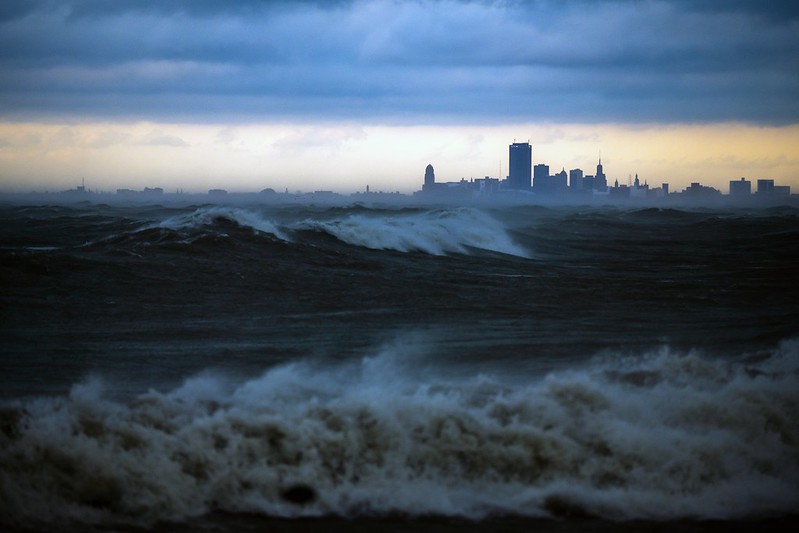
On the waterfront (photo: Darren McGee/Governor's Office)
As New Yorkers head to the polls in this general election, which ends on Tuesday, November 8, there’s more than just candidates on the ballot. Voters across the state will decide on one ballot proposal, with three more for New York City voters only.
These ballot measures, or propositions, are yes/no questions on proposals to enact laws or constitutional amendments. Placed on the ballot for approval or rejection by the electorate, these major questions give enormous power to New York voters.
Question one is a statewide environmental proposal that, if approved, would have a monumental impact and ensure the state invests in equitable, long-term solutions to make communities healthier, safer, and more climate-resilient. The Clean Air, Clean Water, and Green Jobs Bond Act is the most significant environmental and climate opportunity in New York State in the last 30 years. It will enable us to access $4.2 billion worth of investments to protect clean drinking water, reduce flooding, restore natural resources, and reduce air pollution across the state.
The last environmental bond act in New York, all the way back in 1996, allocated $1.75 billion across the state. Then-Governor Pataki proposed the bond act and shepherded it through the Legislature by forming a bipartisan coalition that outweighed historical opposition. Notably, that funding led to forest preserve purchases in the Catskills and Adirondacks, conserved land and water across the state, and established New York’s first brownfield remediation program.
In March 2020, then-Governor Cuomo launched a campaign to pass legislation allowing voters to approve a $3 billion environmental bond act. In September 2021, Governor Kathy Hochul asked legislative leaders to amend the bond issue to include an additional $1 billion. Renamed the Clean Water, Clean Air, and Green Jobs Environmental Bond Act, it was increased to $4.2 billion when the Legislature gave it passage in April to advance the proposal to the voters this fall.
All New York voters should make sure to find the proposal(s) on their ballot and approve question 1, the environmental bond act.
“By putting forth bold plans to move New York into a safer, healthier, and more just future for all its residents, Governor Hochul has shown what can be done when a public official takes the existential crisis of climate change seriously,” said Peter Linderoth, Director of Water Quality, Save the Sound, in one of many supportive statements from long-time environmentalists and climate advocates across the state. The proposal is also supported by many leaders focused on environmental justice and in organized labor.
I’m a first-generation New Yorker, and I’ve lived in the East Bronx my entire life. Earlier this year, I ran for State Senate in New York’s 34th District, which unifies the coastal communities of Soundview, Throggs Neck, Pelham Bay, Country Club, and City Island in the Bronx with New Rochelle and The Pelhams in Westchester County. During my campaign, I was fortunate to connect with thousands of residents living in these shore communities of the East Bronx and Southeastern Westchester.
Across these neighborhoods, each with its own identity and unique characteristics, one thing was familiar — the impacts of climate change were evident. The flooding threats after a sudden and heavy storm continue to be a burden, especially in areas with sewage overflow problems. One rain shower could lead to severe aftereffects; damage to a home, a vehicle, and disrupted infrastructure is expected, in addition to the financial and health-related burdens residents are forced to endure.
When a summer storm would arrive, neighbors would rush to attempt to protect as much of their property as possible. Moving a car to higher ground and clearing basements of valuables were the first steps in preparing for the worst. As the rain comes down, our local infrastructure gets impacted as well; significant roadways and local streets would flood, as would driveways, building lobbies, and basements.
One Pelham resident shared with me that she had seen three of her cars get destroyed due to the power of these surging storms and flash floods. I often heard a popular refrain, “The streets turn into rivers,” as I would speak to voters door to door. A Bronx resident complained that flood insurance had become astronomical at their City Island home due to the regular and destructive flooding they continued to endure. Our sewage overflow systems are over one hundred years old, and rising sea levels exacerbate these concerns for coastal homeowners. Climate change impacts are felt regularly in the East Bronx and Southeastern Westchester.
In other areas of the state, the effects of the climate crisis had far more fatal results, such as when 11 died in Queens during the aftermath of Hurricane Ida due to the flooding of several basement apartments.
In July, Congressman Jamaal Bowman toured several towns affected by Hurricane Ida in Westchester County with the Army Corps of Engineers. The Congressman assessed the issues our Sound shore communities face, and in September, he shared that he had secured millions in federal funding for flood mitigation and flood prevention resources. Thanks to the Inflation Reduction Act, hundreds of billions of dollars will be invested in making our communities resilient and kickstarting the clean energy revolution.
Earlier this year, I believed legislation was the fastest way to address the climate crisis. In the New York State Legislature, the passage of bills like the Climate and Community Investment Act (CCIA), the Build Public Renewables Act, and the Living Shorelines Act are some of the most transformational policy proposals that could significantly impact our state. However, partisan politics and influence from special interests have made passing these bills difficult. The Clean Air, Clean Water, Green Jobs Bond Act uses capital to address critical climate initiatives while creating meaningful union jobs, and our citizenry has the final say! We need to invest in our safety and resiliency, and The Clean Air, Clean Water, Green Jobs Bond Act can help us do that.
Climate change is exposing long-term vulnerabilities in our region. Regardless of socioeconomic status, the many impacts of the climate crisis are projected to worsen — from drastic temperature and sea level changes to more common extreme weather events and shifting storm patterns. A child born today faces multiple and life-long health harms from climate change, growing up in a warmer world with risks of food shortages, infectious diseases, floods, and extreme heat. Climate change is already harming people’s health by increasing the number of extreme weather events and exacerbating air pollution. The air we breathe and the water we drink come at a price, and in communities with marginalized populations, our neighbors are likely to bear the brunt of this crisis.
We face some of the state’s most significant infrastructure and climate challenges. Storms like Hurricanes Sandy, Henri, Ida, and others have revealed flood risks across all five boroughs and lower Westchester. Flooding is affecting coastal communities more than ever, and it’s also become more of an inland problem given our challenges dealing with the most intense rainfalls.
Funding from the restoration, flood risk reduction, water quality improvement, and resilient infrastructure programs of the environmental bond act could jumpstart more coastal rehabilitation, shoreline restoration, green infrastructure, and sewer upgrade projects in flood-vulnerable communities, including environmental justice communities.
As New York faces a long and uncertain path toward economic recovery from the COVID-19 pandemic, the estimated economic impact of the proposed bond act includes support for $8.7 billion in project spending and over 84,000 jobs. These types of investments, working in conjunction with major federal funding initiatives, create good-paying local jobs and provide economic returns to local economies.
One of the most critical components of the bond act is the focus on ensuring that benefits reach environmental justice communities. The measure requires that New York spend 35% of the $4.2 billion on projects benefiting disadvantaged communities.
The bond act would enable multi-year investments across four major categories.
1. $650 million for water quality improvement and resilient infrastructure, focused on projects that protect clean water, such as stormwater infrastructure, drinking water, and wastewater infrastructure projects, pollution control, and lead service line replacements.
2. $1.5 billion for climate change mitigation, including investments in urban heat reduction, energy efficiency in buildings, renewable energy, and reducing air and water pollution.
3. $1.1 billion for environmental restoration and flood risk reduction. This funding will support voluntary buyouts in flood-prone areas; waterfront, wetland, and stream restoration; and dam removal and transportation infrastructure upgrades for flood reduction.
4. $650 million for open space land conservation and recreation. This funding will conserve forests, open space, and family farms and support upgrades to parks and other recreational infrastructure providing new and enhanced access to the outdoors.
Cities, towns, and communities across New York State will reap benefits from the Clean Air, Clean Water, and Green Jobs Bond Act. Every county in New York has declared disaster declarations due to flooding in the last ten years alone, and flooding continues to be the most common climate hazard in the state.
In each decade from the 1960s through the 1990s, New Yorkers approved bond acts to support environmental programs. The 2022 Clean Air, Clean Water, Green Jobs Bond Act is a once-in-a-generation opportunity to access $4.2 billion worth of investments to protect clean drinking water, reduce flooding, restore natural resources, and reduce air pollution across the state, while leveraging billions more coming from the federal government.
When you vote, vote yes on ballot question 1, the Clean Air, Clean Water, and Green Jobs Bond Act.
***
Christian Amato is an organizer, activist, and political strategist, from the Bronx, New York. He is the founder of Consense Strategies. On Twitter @AmatoForNY.
***
Have an op-ed idea or submission for Gotham Gazette? Email This email address is being protected from spambots. You need JavaScript enabled to view it.
We Need to Utilize All Proven Strategies to End Domestic Violence
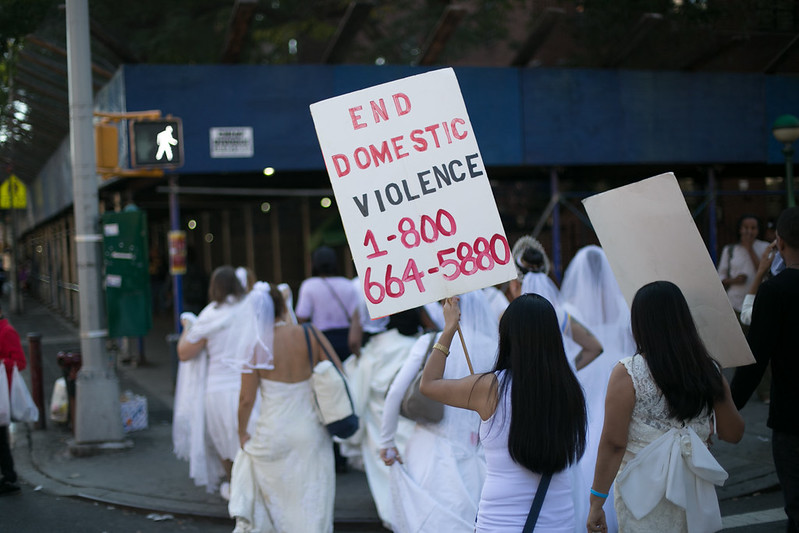
A march against domestic violence (photo: William Alatriste/New York City Council)
Though Domestic Violence Awareness Month has ended, domestic violence is a tragedy that occurs every month, and every day. Uplifting the voices of survivors, recognizing the harm of abuse, and pursuing evidence-based solutions to break cycles of violence must be year-round priorities.
And sometimes, that evidence points in unconventional directions.
Our primary duty is to support survivors of domestic violence. The best way is with comprehensive, intersectional, and culturally-responsive crime victim services that help survivors escape future violence. This means providing safe and stable housing; emergency financial support on everything from food to clothing; and criminal legal system advocacy and guidance. Without these vital supports, we won’t solve this crisis.
Another strategy is to provide trauma-informed support to partners who commit abuse. This may seem like an unorthodox, even controversial, approach. But domestic violence is a unique offense. It involves people in deep, personal relationships with intense emotional connections.
Those who commit domestic violence reoffend at higher rates than virtually every other crime category. One study showed that anywhere from 20% to 33% of violators reoffend within months; another puts the frequency of recidivism in domestic abuse cases at more than 60% within months of a previous incident. And there are troubling signs that the pandemic has worsened domestic violence.
New approaches are urgently needed to break the cycle and actually curb the violent, destructive effects on survivors and families. That means using every strategy available.
Abusive partner intervention programs (APIPs) can reduce crime and provide long-term benefits to both parties involved in an abusive relationship and to the community as a whole – if done the right way. It’s not easy. Abusive partner interventions are challenging. But instead of giving up on these efforts to prevent recidivism, we must reinvigorate our commitment to proven methods that get results.
That means understanding that changing a person’s abusive behavior won’t take place if they are in a traumatized state. We must acknowledge and treat the trauma that so often triggers - and retriggers - violent acts.
This is what trauma-informed, culturally-responsive abusive partner interventions offer, which is dramatically more intensive than traditional APIP programs. The difference is that programs dig deep into both accountability and addressing root causes of behavior.
Importantly, this approach elevates survivor safety first and foremost and emphasizes abuser accountability. Clear protocols for compliance, strict schedules and guidelines, and crystal-clear coordination of services and support drive every part of this strategy. Centering survivors' voices and views in all aspects is a sacrosanct principle.
But understanding how past traumatic experiences can cause present and future behavior provides an invaluable way to prevent harm and violence. Tailored supports can help a person who commits intimate partner violence address and salve their trauma, and engage in the challenging work towards behavior change. Matching resources and designing programs to meet these needs is an innovative way to both identify and address the root causes of abusive behavior.
Providing services to those who cause harm does not excuse their crimes, or shift the burden of their offenses away from them. Abusers are responsible for their actions, and must be held accountable. Part of that accountability should include working to achieve real behavioral changes, which can only happen with trauma-informed engagement. In fact, many survivors want to see their partners receive this support, so cycles of violence can end and healthy relationships can begin.
When done the right way, trauma-informed interventions can help abusive partners develop care and compassion for survivors, do the work required to change their actions, and ultimately accept responsibility for the harm they’ve caused. This accountability is how we break cycles of violence.
We should invest in trauma-informed abusive partner interventions this month and every month, so that when Domestic Violence Awareness Month comes around next October, we can celebrate new, real reductions in this awful scourge.
***
Alison Diéguez is a Program Director at the CUNY Institute for State & Local Governance (ISLG), where she oversees ISLG’s work on gender-based violence and trauma. Nathaniel Tolbert, LCSW, is the Clinical Director of Manhattan APIP’s Urban Resource Institute and Director of URI’s Trauma Informed Abusive Partner Intervention Program and The Mayor’s Office to End Domestic and Gender Based Violence supported Respect and Responsibility Program. On Twitter @URI_NYC & @CUNYISLG.
***
Have an op-ed idea or submission for Gotham Gazette? Email This email address is being protected from spambots. You need JavaScript enabled to view it.
Don't Mistake Lee Zeldin’s Empty Soundbites for Moderation
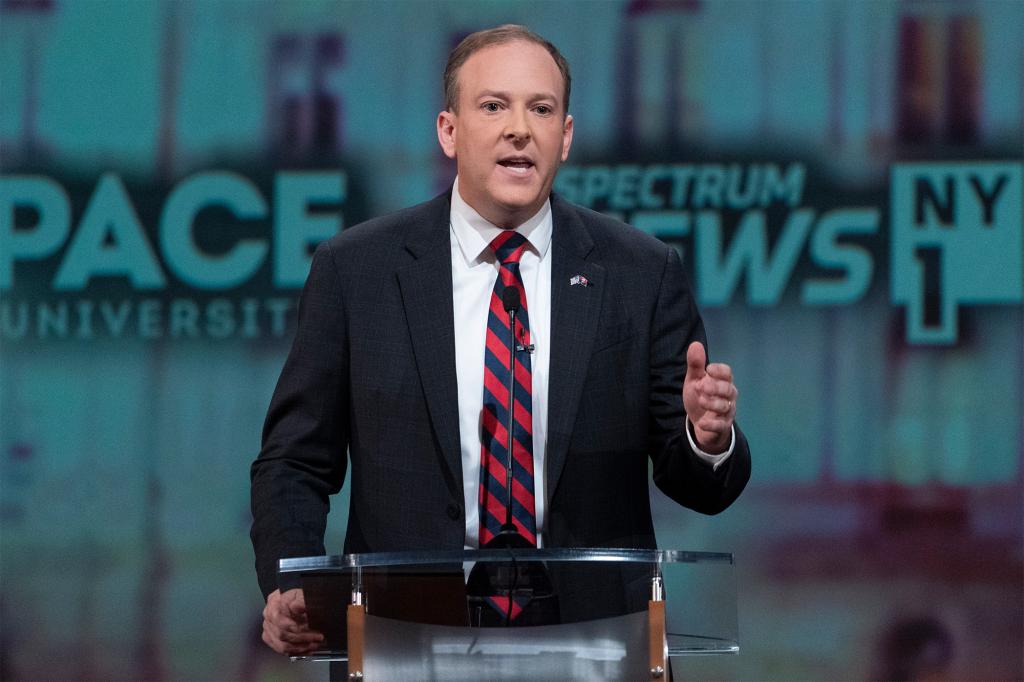
Lee Zeldin at the Spectrum News debate (photo: pool)
In 2020, I ran for Congress in Suffolk County on a platform of facts, truth, and evidence-based solutions for my local community. My opponent was Republican Rep. Lee Zeldin, who already had a long history in Congress of denying facts and relying on soundbites to take the place of real accomplishments. With the gubernatorial election happening now, New Yorkers need to look beyond Zeldin’s shallow rhetoric, and instead look at his record to truly understand the harmful agenda he will bring if elected to the highest office in the state.
Mr. Zeldin claims a mantle of “bipartisanship.” Unfortunately, as a member of Congress he accomplished little and voted with President Donald Trump almost 90% of the time. To hide this reality, Mr. Zeldin likes to claim credit for actions that are important to his voters, without doing the real work to make things happen.
For example, in 2020, Brookhaven National Lab (BNL), which lies within our district, was selected as home for the U.S. Department of Energy’s Electron Ion Collider (EIC), a $2 billion project that will bring jobs to our community. An independent panel of scientists had chosen BNL as home for the future EIC because it had the best combination of expertise and existing facilities to support the project. Yet Mr. Zeldin sent out a press release with the headline “Rep. Zeldin Steers Electron-Ion Collider Project to Brookhaven National Lab.” The release conspicuously did not include any mention of what Mr. Zeldin did to support BNL’s bid.
Meanwhile, Mr. Zeldin’s extremism includes serving as a staunch supporter and passionate defender of former President Trump. In Congress, Zeldin served as Donald Trump’s “point man” during both impeachment trials, and planned with White House Chief of Staff Mark Meadows on how to undermine the 2020 election results. If you want to understand who Lee Zeldin is, listen to the speech he gave on the night of January 6, 2021, after the Capitol insurrection, to justify his vote against certifying the election results. Each sentence is carefully crafted to be true in its narrowest sense, but taken as a whole, the speech is one big lie.
To this day, Zeldin skirts around the facts and fails to give direct answers so as not to upset his base. Asked recently by The New York Times editorial board whether he agrees that Joe Biden won in 2020, Zeldin avoided answering, instead saying, “I don’t know how to quantify nationwide what happened. All I know from the most personal of experiences was what we went through in the 1st Congressional District in New York.” Ironically, I lost to Rep. Zeldin in 2020, and he has never questioned that result.
To make matters worse, Zeldin has aligned himself with far-right ideologues. In 2015, Zeldin hosted a town hall with members of the Oath Keepers, an organizing group behind the January 6, 2021 insurrection. Likewise, he has welcomed the enthusiastic support of the Long Island Loud Majority, which has been identified as an anti-government extremist organization by the Southern Poverty Law Center.
Mr. Zeldin’s voting record is similarly extreme, including voting against the bipartisan infrastructure bill, against the John Lewis Voting Rights Act, against the Assault Weapons Ban, and for repealing the Affordable Care Act, to name just a few. Staunchly anti-abortion with a long record to prove it, he now says he will not try to overturn New York’s legislation protecting reproductive rights, but he has made no similar promise to continue critical state funding to protect those rights. Once again, Zeldin is crafting his message carefully, yet overall it is a giant lie, trying to trick more pro-choice people into voting for him.
Mr. Zeldin wants to be our Governor – a position of tremendous power and consequence for each of our day-to-day lives. I implore New Yorkers to judge him not by his big claims or promises, but by what his record and choice of friends tell us he would do if we hand him the keys to the governor’s mansion. Then, vote like our state depends on it.
***
Nancy S. Goroff is a Long Island resident and former congressional candidate. On Twitter @ngoroff.
***
Have an op-ed idea or submission for Gotham Gazette? Email This email address is being protected from spambots. You need JavaScript enabled to view it.
Empowering New York City’s Asian American Voters
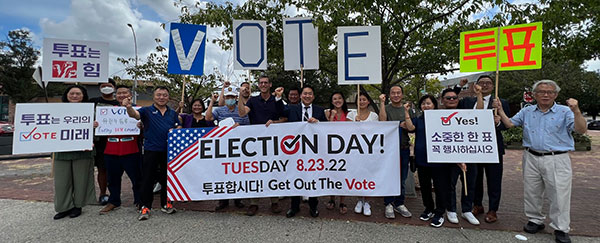
Getting out the vote (photo: @SandraForNY1)
Asian Americans are the fastest growing racial group in the United States and in New York City. Yet for too long, Asian Americans have faced challenges participating in elections. We now make up over 17% of New York City’s total population, making us a significant part of the city’s racial diversity, cultural fabric, and electoral politics. However, we often are not included in voter outreach and face extra barriers to casting our votes. As we gear up for an important election, it’s time to acknowledge and uplift the power of Asian American voters.
Asian American Pacific Islander (AAPI) voter turnout has historically been stymied by language barriers and a lack of translated voter materials, which is especially impactful given that 45% of Asian Americans in New York City have limited English proficiency. We are also vulnerable to voter suppression tactics, such as higher rejection rates of ballots cast by Asian Americans and limitations on mail-in voting, which Asian Americans are more likely to use. This has placed the label of “unlikely voters” on our community, which in turn causes officials and candidates to not bother to engage with us, creating a vicious cycle.
With elections affecting so many important policies and services, from funding to safety to empowerment resources, it is more important than ever to keep in mind how New York City’s rapidly growing AAPI voting community will be affected.
Asian New Yorkers make up at least 10% of the population in more than one-half of New York City Council districts, but there are neighborhoods with concentrated Asian voters. In these concentrations, it is actually easier and more effective for candidates and campaigns to canvass them and make voting more accessible. Such as by making a few adjustments to the already existing system, providing interpreters at polling sites, or offering translated candidate and campaign information.
The good news is there are evidence-backed, actionable ways to break this cycle and make Asian Americans very likely voters. In a new study this year, the Asian American Federation’s AAPI Power Coalition measured the effectiveness of different voter outreach techniques and found that face-to-face canvassing and phone banking with multilingual callers were the best ways to directly reach Asian American voters with limited English proficiency.
Multilingual voting guides with practical information on how to vote also increased turnout, as well as leveraging community events in historically low turnout areas to create a stronger culture of voting. These tactics drove an 11-percentage-point increase in voter turnout among targeted Asian voters, compared to their non-targeted counterparts.
Asian Americans can also be better accommodated once we reach the polls with more on-site translators in the myriad of Asian languages spoken in New York City.
Already, we are seeing a growth in Asian American electoral participation. As the AAF report highlights, in the 2021 New York City primary, 27.1% of Asian voters cast ballots. That was the highest turnout rate of any racial minority group, surpassing Black voters at 26.5% and Hispanics at 17.4%. It was also an 11-percentage point increase in Asian voter turnout since 2013, the last time there was a competitive mayoral primary in the city.
As our community grows rapidly in both size and voter turnout rate, it’s clear that Asian Americans are poised to become a powerful voting bloc in New York. It is in the interest of all candidates and election officials to build the foundation now for our voices to be heard, with accessible, translated voting information and meaningful outreach.
***
Sandra Ung is a New York City Council member representing parts of Queens and Chair of the Council’s Committee on Governmental Operations. Jo-Ann Yoo is the Executive Director of the Asian American Federation. On Twitter @SandraForNY1 & @AAFederation.
***
Have an op-ed idea or submission for Gotham Gazette? Email This email address is being protected from spambots. You need JavaScript enabled to view it.
Senator Schumer, as New York Legalizes Marijuana, We Need SAFE Banking Now
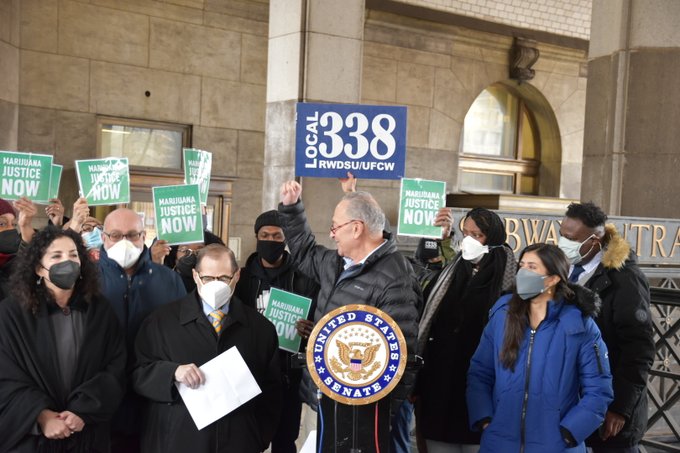
Senator Schumer rallies around "marijuana justice" (photo: @SenSchumer)
I am a proud Long Island resident, mother of two, working wife, and cannabis entrepreneur. As an active and concerned member of the community, I urge U.S. Senate Majority Leader Schumer and other lawmakers to rally behind the common-sense Secure and Fair Enforcement (SAFE) Banking bill. The SAFE Banking bill would prohibit enforcement action by the federal government against financial institutions that provide services to the cannabis industry.
Now is the time to act.
In October, President Biden announced to great fanfare that he will pardon all federal convictions for simple cannabis possession, called upon governors to do the same at the state level, and requested staff to initiate “expeditiously” an administrative review process to remove cannabis from the list of scheduled drugs.
Currently, federal law classifies marijuana as a Schedule I substance under the Controlled Substances Act. This classification is reserved for the most dangerous substances with no perceived medical benefit. This schedule classification of marijuana is even higher than that assigned to fentanyl and methamphetamine, the drugs driving today’s overdose epidemic.
Cannabis is no longer viewed as a danger. Nevertheless, the War on Drugs still encompasses cannabis and targets minority populations. As New York legalizes the cultivation, sale, and adult use of marijuana, the State Legislature has begun to address long-standing inequities by adopting legislation that specifically calls for a majority of cannabis licenses to be granted to those most impacted by the discriminatory policies of the past and small, minority/women-owned businesses. These are terrific advances, but if lawmakers do not ensure that entrepreneurs have access to the sophisticated federal financial system, our entrepreneurial business advances are doomed to failure.
As it currently stands, banks and other financial establishments do not provide banking services to cannabis-related establishments, forcing them to operate entirely in cash and causing serious economic constraints. Without banking access through the passage of the SAFE Banking bill, the cannabis legalization effort will flounder — or worse, fail completely, and the illicit unchecked cannabis market will dominate.
The principal objective of cannabis legalization is to create and promote a safe environment and market for the safe distribution of cannabis. There are real dangers associated with any delay in taking real action to facilitate the formation and successful operation of the small minority-owned businesses that are and will be best-suited to be at the forefront of the cannabis market changes.
It is antithetical to this goal to deny the field soldiers access to the legitimate banking resources needed to operate safely and soundly. Adoption of the SAFE Banking bill, which has passed the House of Representatives six times and now sits in the Senate, would be a great start to addressing these issues and more.
Senator Schumer is one of several legislators that has publicly and vocally supported SAFE Banking and further cannabis reform – but we need more. I urge Senator Schumer and his colleagues to support this bill.
***
Beryl Solomon Jackowitz is a cannabis advocate and founder of Poplar, an online health and wellness website that sells hemp-derived CBD products.
***
Have an op-ed idea or submission for Gotham Gazette? Email This email address is being protected from spambots. You need JavaScript enabled to view it.
Latino New Yorkers Know Governor Hochul is Fighting For Us
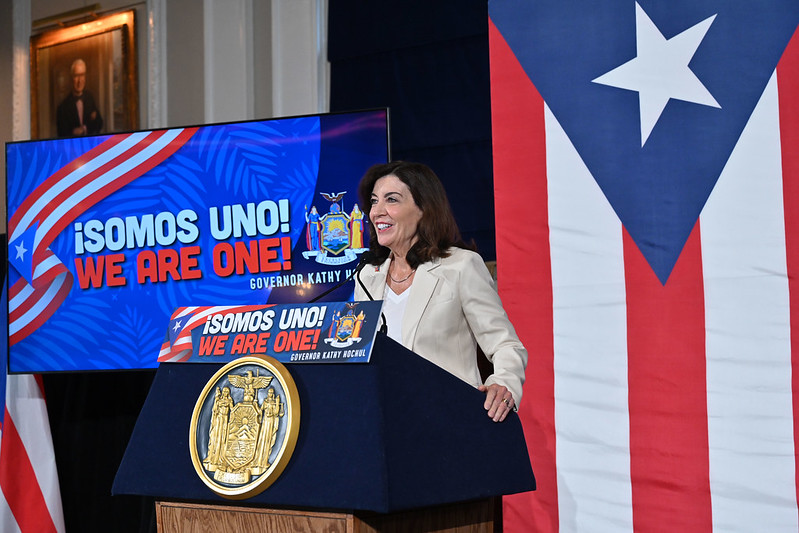
Gov. Hochul celebrates Puerto Rico (photo: Kevin P. Coughlin/Office of Governor Kathy Hochul)
Every election season, Latinos have the same conversations about how political candidates engage with us. My constituents and I are used to seeing chronic underinvestment despite big promises, and our communities are used to feeling like an afterthought. It’s far too easy for us to succumb to cynicism about our political leaders’ commitment to fighting for us.
But that’s not the case with Governor Kathy Hochul. And she’s proven it time and time again on the campaign trail and through her legislative and budgetary victories for our community.
With Election Day around the corner, Kathy Hochul is fully engaged with the Latino community. Her campaign has prioritized Latino investment with a seven-figure Spanish ad buy that reaches members of our communities across the state, on the airwaves, and through digital ads.
She’s also working hand-in-hand with Latino elected officials to speak to constituents across the five boroughs, which I saw firsthand when I joined her campaign to reach voters in Washington Heights. The impact of in-person voter engagement is truly immeasurable, and her team is putting in the crucial face-time that our voters need.
In May, the governor and the State Democratic Party launched the “Nueva York Initiative,” a first-of-its-kind bilingual empowerment program dedicated to coalition building, voter registration, and mobilization in the Latino community in 2022 and beyond.
The actions Governor Hochul has taken show that she views Latino voters as more than a mere item on her campaign’s checklist. She understands the importance of sharing her message with non-English speakers so that we can all show up to the polls informed about what the Governor is fighting for, from keeping guns off our streets to creating jobs and bringing down the cost of living.
Although Governor Hochul has only had a relatively short time in office, her accomplishments for the Latino community have gone far.
Communities of color are often hit the hardest by gun violence, and polling shows crime as a key issue among Latinos. Governor Hochul has stepped up to protect our neighborhoods by passing common-sense gun safety laws that keep weapons out of the wrong hands and providing law enforcement officials with the tools to crack down on the distribution and possession of illegal weapons. Governor Hochul knows that New Yorkers deserve to move through their days free of fear and has taken decisive action to keep us safe.
The governor has also made historic advancements in New York’s economic recovery by accelerating $1.2 billion in middle-class tax cuts for 6 million New Yorkers and providing $100 million in relief for nearly 200,000 small businesses, working to ensure an equitable pandemic recovery for all.
In the wake of Hurricane Ida, Governor Hochul made $27 million in storm relief available to New Yorkers, including those in my community, to support individuals who were ineligible for federal aid. When Queens residents’ basements flooded during the storm, Kathy Hochul was the first to pick up the phone and lend a hand in their hour of need.
Governor Hochul has proven that fighting for Latino communities makes our state a stronger, more prosperous place. She is a true ally to our communities, and she’s shown it by listening and executing on the issues that matter to us most in Albany and in our streets. Governor Hochul is the real deal.
***
Diana Ayala is a New York City Council Member representing East Harlem and parts of the South Bronx. On Twitter @DianaAyalaNYC.
***
Have an op-ed idea or submission for Gotham Gazette? Email This email address is being protected from spambots. You need JavaScript enabled to view it.
Ten Years After Sandy, New York is More Resilient Than Ever, with More Work to Do
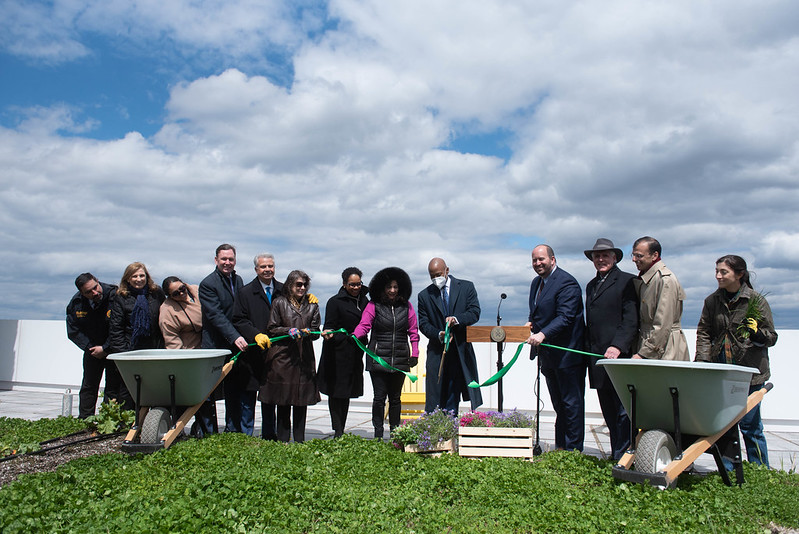
Resilient planning (photo: Michael Appleton/Mayoral Photography Office)
Ten years ago, New York City received one of the biggest wake-up calls in its history – climate change was here, and we were not ready.
Superstorm Sandy, which killed 44 New Yorkers and caused $19 billion in damages and lost economic activity, was the first massive climate-change-driven storm to hit the five boroughs — and, as we are now well-aware, it wouldn’t be the last. We did learn some very important lessons.
First among them: if we are going to build, and rebuild, we need to build resiliently. That is because newer structures built under modern construction codes are standing up to powerful storms much better than older buildings. This fact is underlined again and again, most recently in Florida as Hurricane Ian swept up the Gulf Coast.
So, what are we doing about this? Alongside resiliency work New York City government agencies are undertaking from our shores to our streets, the Department of City Planning and the Department of Buildings are today pushing forward Mayor Adams’ City of Yes for Carbon Neutrality. This wide-ranging zoning proposal will make it easier to green our grid, reduce our carbon emissions, and protect our homes, parks, and job spaces.
Since Sandy, the City has worked to protect our 1 million buildings. We’ve done this by updating construction and zoning codes to make certain that newly-constructed homes and businesses can stand up to and recover faster from more intense weather events – including by allowing property owners to move boilers out of their basement and to raise living space up and out of harm’s way. In a few days, stringent new construction codes related to critical facilities in the floodplain, such as hospitals and fire stations, will go into effect. Just 30% of municipalities in the United States have taken on this work to bake resiliency into construction codes.
Because these codes are only half the battle, we are also fully focused on the second battleground: reducing New York City’s carbon contribution to climate change.
Some ways that we propose to do this are to make it easier to install energy efficient building façades and solar panels on roofs and allow electric vehicle charging in and on many more structures. Today, for instance, we generate about 300 megawatts of electric energy per day through rooftop solar panels. The City of Yes for Carbon Neutrality proposal would eliminate barriers and more than triple the amount of electricity the sun would generate for New York City over the next eight years. That alone is enough energy to power over 70,000 homes.
Our carbon neutral work is more expansive than solely updating construction and zoning codes, but they are important building blocks for a healthier city. Further, this work will help landlords introduce retrofits into existing buildings and make new buildings greener, as required under Local Law 97.
If we want to achieve carbon neutrality, home and business owners need as clear a path as possible to making investments that reduce their energy costs. City of Yes is intended to help large and small landlords to get green and help us meet our carbon emission reduction goals.
As we remember the destruction Sandy caused and celebrate our progress on creating climate-related infrastructure and rules, let’s not be complacent. It continues to be essential to say yes to a greener, more resilient future, and we hope all New Yorkers will support our plans to get there.
***
Dan Garodnick is Chair of the New York City Planning Commission and Director of the New York City Department of City Planning. Eric Ulrich is the Commissioner of the New York City Department of Buildings. On Twitter @DanGarodnick & @Eric_Ulrich.
***
Have an op-ed idea or submission for Gotham Gazette? Email This email address is being protected from spambots. You need JavaScript enabled to view it.
How Could the City Council Cut Affordable Housing in Gowanus?
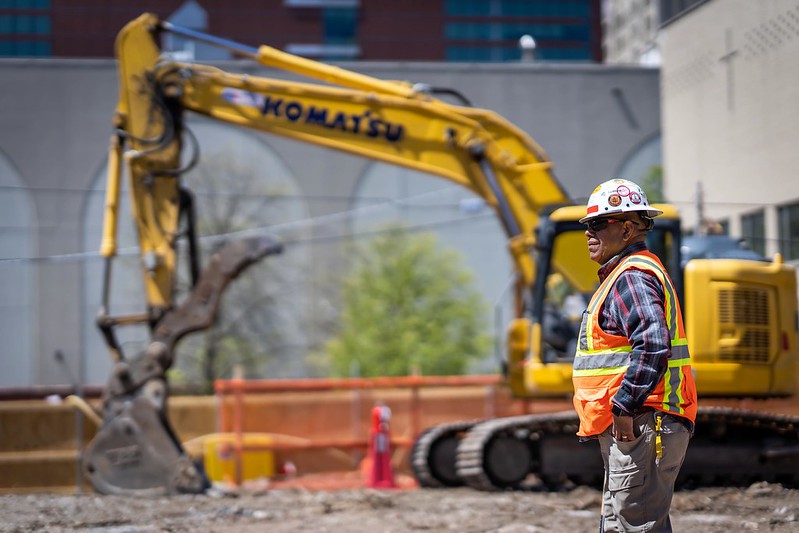
Housing construction (photo: Ed Reed/Mayoral Photography Office)
If you listen to progressives in New York City talk, you'd think they're focused on addressing our worsening housing crisis. Endless rally cries for tenant protection and increasing affordability make up the bulk of their campaign promises and slogans.
And they would be right to — everyone, from democratic socialists to President Biden agree housing production is a problem. Over half a million units are needed by 2030, according to a study commissioned by the Real Estate Board of New York.
But when you get past the rally speeches and look instead at actions taken by some progressives in the City Council, you’ll often find something very different. In fact, some of them continue to reject or water down housing proposals that would bring hundreds or sometimes thousands of units, many of which would be affordable, to their districts.
For example, this week, the Co-Chair of the City Council’s Progressive Caucus, Shahana Hanif, negotiated to limit the size of a project in her district, thereby limiting the amount of affordable housing required through the city’s Mandatory Inclusionary Housing program, which requires developers to provide affordable housing in exchange for a rezoning that allows for more housing development.
This dilution of the Mandatory Inclusionary Housing overlay will eliminate the opportunity for additional below-market-rate housing units to be built and effectively allow her majority-white, affluent district to avoid doing its fair share to welcome new rental housing and alleviate the city’s housing crisis.
Based on neighborhood NIMBYism, Hanif turned a would-be nine-story building that would provide 48 apartments, 13 of which would be affordable, into a five-story building that will have, at most, 23 apartments, with only three to six of those deemed affordable.
You would hope the Council Member would seek to create a clear contrast and insist that her district accept more of the responsibility to provide housing rather than continue the district’s lagging production levels. From 2014-2021 the City Council District she represents only produced 253 units of affordable housing, about 20% of the city average. Meanwhile, as District Manager of Bronx Community Board 6, I supported the board in routinely supporting new housing, as shown by the Council District we overlapped with producing 12 times as much housing, with 3,115 units during the same period.
While the project is small, every effort at building housing matters. Even a single affordable apartment is momentous to a family that has lived in a shelter for years, a city worker seeking a shorter commute to spend more time with family, and the immigrant family with humble beginnings looking to start a new life in New York. By continuously working against critical housing proposals, some City Council Members are undermining the only real chance at creating housing that would address the current crisis and actively working to prevent future generations from being able to experience our great city.
All of this comes after Hanif and others campaigned on the lack of housing affordability. Yet in this case the Council Member is undermining a project that would deliver exactly that. It’s incomprehensible.
She states that she respects and supports the push from many in her community to increase affordable housing — particularly deeply affordable housing. Sadly, the typical scope of community input ignores the voices of undocumented New Yorkers, New Yorkers without permanent addresses, and New Yorkers on affordable housing waiting lists that number in the tens of thousands. Comfortably housed people should no longer be able to limit how many people and what type of people can live in our city.
If the Progressive Caucus’ commitment is to affordability, then there should be more than respect – there should be decisive and bold action. The rules that govern what can and can’t be built in our city largely come from the 1961 zoning resolution. These rules were made exclusively by men who wouldn’t be representative of our city today in a time before the Civil Rights and Fair Housing Acts were passed. The Caucus could propose moving our city forward and no longer clinging to these outdated rules that tend to keep people out of neighborhoods based on their income, and maintain New York City’s deeply segregated nature.
With an influx of migrants seeking refuge in our great city, the chair of the Immigration Committee (yes, Hanif as well) might be expected to be a champion of bringing immigrants into safe, new homes. Instead, she is reducing the number of affordable apartments potentially available to immigrant families in her community.
The next time the City Council wants to look for a reason as to why there isn’t enough housing being built, they should examine why they defer to a single member that wants to limit how much housing and affordability is allowed. If the entire City Council truly wants to bring affordability to tenants, help working-class people, and improve their neighborhood amenities, then they need to approve projects that will provide just that and not approve deals that decrease affordable homes. People across all five boroughs are tired of excuses. People are tired of the excuse of “member deference” when it comes to explaining why it’s so difficult to provide affordable housing for a city of more than 8 million New Yorkers.
Most of all every City Council Member should ask themselves this: How many new homes do you want to see in your district by the end of the decade and what is your plan, including legislation and funding needed to happen to reach this goal? A goal without a plan is a wish, and we can no longer have a New York where a desire to live in a secure home at a reasonable price is a faraway dream achievable only by six-figure households.
When promises for housing affordability are made and then broken, there should be accountability. New Yorkers don’t want to be sold dreams anymore; we just want to have a fighting chance to afford to live here.
***
John Sanchez is the former District Manager of Bronx Community Board 6. On Twitter @NYJohnSanchez.
***
Have an op-ed idea or submission for Gotham Gazette? Email This email address is being protected from spambots. You need JavaScript enabled to view it.
Latinos, Hochul, and the 2022 Election for New York Governor
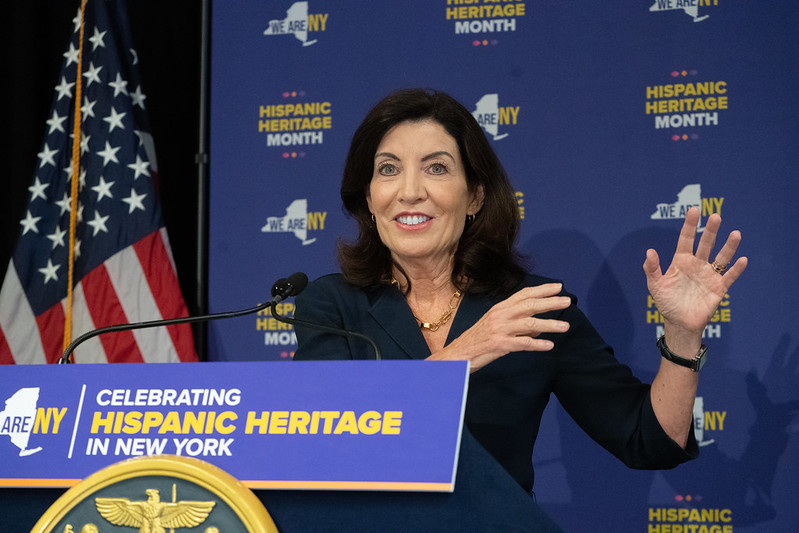
Gov. Hochul celebrates Hispanic Heritage (photo: governor's offiice)
She once adamantly opposed the idea of giving drivers’ licenses to undocumented immigrants; she even went so far as to threaten their arrests and deportations. No Latinos were on the original list of speakers for the convention of the State Democratic Party, of which she is the de facto leader. The Nueva York Initiative the party established as an effort to woo Latinos would, they said, only generate a “multi-year, six-figure investment.” A paltry six-figure amount is not nearly enough to make a dent among Latino voters. Though a lieutenant governor with a Latino-sounding name was appointed, Antonio Delgado is not actually a Latino. And when new party executive leadership was selected not too long ago, no Latinos were on the list.
With an abysmal record on Latino matters, can Governor Kathy Hochul win the Latino vote in this year’s election? The short answer is “yes—but.” She may win their vote, but it’ll likely be with a smaller margin than that of any of her Democratic predecessors.
Much has been said about the non-homogeneity of Latinos, and that is certainly true. Latinos come from a variety of Latin American countries, with differences in culture, language accents, and the like. Yet despite this wide-ranging diversity, Latinos in New York tend to vote Democratic and for the most part align on issues of importance. For example, a UCLA study showed that 78% of Latinos in high Latino-density election districts in New York voted for Joe Biden in the 2020 presidential election.
At the statewide level, Latino voting preferences tend to follow the same Democratic line. By my own estimations, Andrew Cuomo’s support among Latinos in his elections hovered between 62% and 65%. Most public polling data tended to show slightly lower levels of Latino support, as this Siena College poll taken close to the 2018 election demonstrates.
Among the public polls that included Latinos in their crosstabs, Cuomo would tend to poll in the high 50s to low 60s. We must bear in mind that most public polls have a tendency of missing the mark on Latino support since they fail to correctly sample Latinos within their surveys. For instance, polls that undersample Latinos increase the margin of error in the Latino demographic and create particularly imprecise data.
These inaccuracies notwithstanding, Hochul has been polling at lower levels than Cuomo among Latinos. This October Siena poll had Hochul at 56% among Latinos.
An October Marist poll had Hochul at 55% with Latinos, where an October SurveyUSA poll had Latino voter support for Hochul at 45% with an additional 19% of Latinos polling undecided. Again, despite the undersampling of Latinos, these Hochul numbers suggest that her level of support among Latinos is still lower than Cuomo’s.
Yet I suggest that these Hochul numbers do not necessarily represent Latino defection from the Democratic Party or from Democratic candidates and thus a pull to embracing conservative candidates and ideologies. Current voter registration data does not suggest significant Latino defections from Democrats to Republicans. Furthermore, recent election results, like Eric Adams’ victory last November, also do not show any evidence that Latino voters in New York City (75% of Latino voters statewide reside in the City of New York) are leaving the Democratic Party or its candidates in droves. Latino support for the Democrat Adams resembled support for previous Democratic mayoral candidates.
Furthermore, the recent polling on the 2022 general election may also bear this out. Latino support for Senator Chuck Schumer’s reelection is at 57% (versus 45% for Hochul) in the SurveyUSA poll, 63% in the Siena poll (to 56% for Hochul). The Marist poll is the only public poll that has Hochul receiving a higher percentage of the Latino vote than Schumer (55–53%). When it comes to support for President Biden and Democratic congressional candidates, Latino support is consistently in the 60% range, also higher than Latino support for Hochul.
So, what gives with Hochul?
Several factors may account for Hochul’s lower numbers among Latinos than her predecessor. On one hand, most public polls indicate that crime remains the key issue for Latino voters, more so than economic concerns. It may be the case that Latinos are not happy with Hochul’s handling of crime, which typically hits communities of color harder than other demographic groups. Lee Zeldin, Hochul’s Republican challenger, is running the typical GOP election playbook and hammering Hochul on the significant crime problem in New York.
Second, the lower level of Latino support may be a consequence of Hochul’s election strategy, one which many have deemed an equivalent to the Rose Garden strategy made popular by William McKinley in the late 19th century and Jimmy Carter in the 20th. Hochul has refrained from the type of sustained retail politics that Latinos appreciate and by which they are motivated.
Lastly, Latinos may be getting tired of a political party that seemingly has only paid lip service to the needs and demands of its communities, from public safety and small businesses to education and housing. And even when the party and its leaders make attempts to reach into Latino neighborhoods, they respond with paltry attempts like that of the Nueva York Initiative and its minor “investment.”
Yet, Latinos across the nation and in New York have consistently and faithfully pulled the levers for Democratic candidates, including Governor Hochul in June’s Democratic primary. Many Latinos would say that they have not left the Democratic Party or its leaders; the party and its leaders have left the Latino constituency
Hochul has her work cut out for her in Latino neighborhoods across the state. The last two weeks of the race will be critical for her election efforts, particularly as campaigns shift into get-out-the-vote. Will Latinos see their governor?
***
Eli Valentin is a political analyst and author of the forthcoming book, Reinhold Niebuhr: A Political Life. On Twitter @EliValentinNY.
***
Have an op-ed idea or submission for Gotham Gazette? Email This email address is being protected from spambots. You need JavaScript enabled to view it.
People Living with HIV in New York Need Housing Support Now
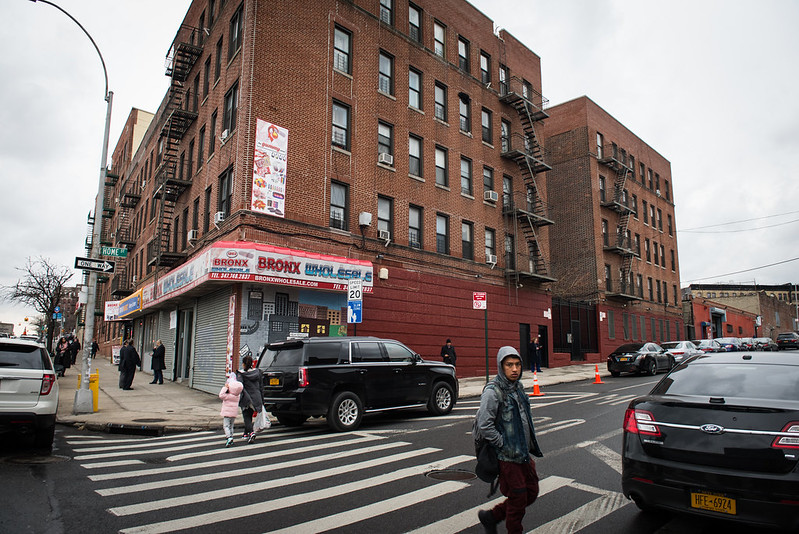
Housing (photo: Edwin J. Torres/NYC Mayoral Photography Office)
If you haven't learned how hard it is to find housing in New York these days, I envy you. Whether it’s a one bedroom apartment or a house with room for three kids and a dog, everyone can feel the strain of jacked-up prices and limited options. The difference is, if you’re living in a place upstate like I am in Rochester, the supply is even more limited. And that’s before you factor in that I’ve been living with HIV for more than 20 years.
It’s easy to see the signs of a housing crisis right now, but people living with HIV have faced housing insecurity for decades. Unlike those living in New York City with the HIV/AIDS Service Administration (HASA), once you cross city limits, support is almost nonexistent. If New York State wants to address the whole of this current housing crisis, our policy-makers must provide the same public assistance for people living with HIV/AIDS outside New York City.
Since being diagnosed with HIV in 2000, there are few things in my life the virus hasn’t affected. I kept it a secret from my daughters and other family members, for fear of what they would think. When I was incarcerated in 2014, people referred to it as “The Monster,” and if anyone knew I had it, I would be shunned. And when I was at risk of being evicted by my landlord during the pandemic, I faced risking my life by entering a shelter.
Housing is healthcare, no matter what condition you’re living with. And for those living with HIV, it’s the difference between life and death. It’s not the virus itself that could kill us – it’s the illnesses that we can’t fight off that put us at risk. And the one sure way to come in contact with those deadly risks is not having stable housing.
Housing is so much more than having a roof over your head when you live with HIV. Housing means having a fridge to store your medication in cold temperatures so it’s safe to take. Housing means having a place to store the belongings that keep you alive, instead of moving them from shelter to shelter. Housing means having a bathroom and kitchen to take responsibility over your own hygiene and nutrition. But people living with HIV outside New York City face the most obstacles to getting permanent housing.
While the intersection between housing and healthcare is not new for people living with HIV, our state does have a renewed opportunity to do something about it. On Wednesday, October 26, the Assembly Committee on Social Services will have a hearing in New York City to discuss public assistance for the coming year, while we’re still reeling from the pandemic.
While it’s ironic that the hearing is being held in the one place in our state where people with HIV have the most support, that's even more reason for us to make our case. While I can’t be there in person, I will join other members of VOCAL-NY’s Positive Leaders Union in testifying that lawmakers carve out funding in the state budget to house people living with HIV outside the five boroughs. Whether it’s solely through the budget process, or budget funding accompanied by legislation, the importance of housing for people living with HIV can no longer be overlooked.
With enough funding, we won’t have to rob Peter to pay Paul to provide this support. Making sure people living with HIV have stable housing to keep them alive does not mean the rest of New Yorkers shouldn’t get housing too. We cannot operate from a mentality of scarcity. With budget funding for public assistance, in addition to Good Cause legislation and an improved voucher program, we can help more New Yorkers than ever before, in a time when we need it most.
This is not a fight between people looking to get housed — this is a fight against greedy, discriminatory landlords and the lawmakers that allow it to continue. People with HIV living anywhere outside of New York City have been left out in the cold for too long, figuratively and literally. We need to bring our most vulnerable communities up to a level playing field when our housing market is as competitive as it is right now.
Stable, permanent housing has always been a requirement for all people living with HIV, no matter their zip code. It’s time New York State made it a reality.
***
Tracie Adams is a HIV+ leader with VOCAL-NY and lives in Rochester, New York. On Twitter @VOCALNewYork.
***
Have an op-ed idea or submission for Gotham Gazette? Email This email address is being protected from spambots. You need JavaScript enabled to view it.
Still Planning for Climate Change Ten Years After Sandy

Climate resiliency envisioning (photo: mayor's office)
Superstorm Sandy’s impact on New York City must not be forgotten: 44 people died citywide, over 69,000 homes were damaged, and Brooklyn’s waterfront neighborhoods flooded in an area more than twice as large as the 100-year floodplain. Over 2 million New Yorkers lost power, stranding some residents – especially those in public housing – for weeks before power was restored.
Now it’s a decade later and we’re still recovering from the last storm and completely unprepared for the next one. We need to reinvigorate our recovery and resiliency efforts now, executing on investment opportunities, changing how we deliver on capital projects, and entirely rethinking how we build our city.
We have to start by understanding the status of our recovery and resiliency projects 10 years after Sandy struck our city, and we need not look further than New York City Comptroller Brad Lander’s extensive report published earlier this month.
The Comptroller demonstrates that the City has spent $11 billion, or 73%, of the $15 billion in federally-allocated grants appropriated for projects resulting from Sandy. He concedes that this is a bit of progress from 2019, when only 54% of these grants had been spent, but projects remain incomplete, with some not slated to be finished until as far out as 2030. Some projects are underinvested – only 0.3% of funding to raise shorelines has been spent, which would help protect neighborhoods such as Coney Island – and since the NYC Sandy Tracker only shows federal funds spent, the City’s own low capital contributions are concealed.
We’ve got to ramp up our investments at all levels of government, and this funding must be strategically targeted to ensure projects are generating the greatest possible protections for our communities. This means we need transparency. By implementing grant accounting procedures for federal funds and improving how we publicly track capital projects, we can empower leaders, advocates, and communities to ensure our spending is sufficient, sustained, and allocated correctly. At the same time, we have to strengthen the City’s ability to execute these projects on budget and on time.
First Deputy Mayor Lorraine Grillo’s Capital Process Reform Task Force has initial recommendations ready to go that would accelerate the pace of incomplete resiliency projects and future projects. We should implement those now if we’re going to successfully scale our transformative spending opportunities – like the $4.2 billion that the state’s Environmental Bond Act, if passed this November, would set aside to fund climate resiliency, natural protection, and clean energy projects while boosting the long-term security of funding for climate resiliency projects across our state.
But all this talk of money and project execution is nothing without the planning that will guide it. One of my main priorities as Brooklyn Borough President is to rethink how we approach our built environment through comprehensive planning.
Instead of piecemeal rezonings or scattered and inequitable development, we must zoom out and look at our city holistically. We should consider how development in one neighborhood may affect the others nearby, the way our environment informs the health of our residents and communities, and how our built and natural environments interact. Then, we build our city planning around this data and the deep understanding of where resources are abundant and where they’re needed.
To understand what this means in the context of climate change, we can look to our NYCHA public housing. Today, 17% of NYCHA’s buildings are in the 100-year floodplain, but by mid-century, this number will grow to 26% – one in every four NYCHA developments. Still to this day, Red Hook Houses is dealing with the consequences of Sandy, including issues with electricity, plumbing, and mold.
Our public housing residents deserve better, and we’re already confronting a housing crisis displacing far too many of our neighbors. This is where comprehensive planning comes in, requiring that our urgently needed new development is resilient and affordable, indicating where we do or don’t want to grow, and helping us to ensure that vulnerable populations aren’t being encouraged to move to at-risk areas like floodplains.
The recovery and resiliency of our public housing, as well as the risks facing our industrial and manufacturing facilities, neighborhood parks, and other essential infrastructure (a whopping 79% of our transportation and utility land uses that support everything from electric and gas utilities to railyards and airports are located in the floodplain), are challenges we have to solve now.
We don’t have the luxury of time – and a coordinated vision for the City’s future, tied to the City’s budget and grounded in interagency collaboration, would lead to the more efficient allocation of resources for the large-scale projects we require. Our short political cycles have hindered us from creating a long-term plan to deal with the reality of climate change, and the pressure is on. There is a better way.
***
Antonio Reynoso is Brooklyn Borough President. On Twitter @BKBPReynoso .
***
Have an op-ed idea or submission for Gotham Gazette? Email This email address is being protected from spambots. You need JavaScript enabled to view it.